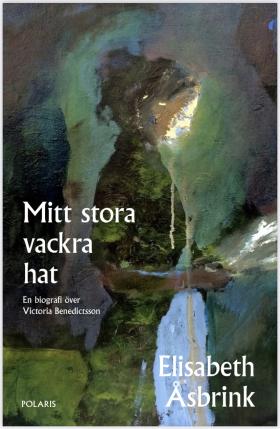
Mitt stora vackra hat. En biografi över Victoria Benedictsson.
(My Big, Beautiful Hatred. A Biography of Victoria Benedictsson.)
by Elisabeth Åsbrink
reviewed by Fiona Graham
‘Beautiful’ is an adjective rarely applied to hatred. Victoria Benedictsson, who fought throughout her short life for recognition as a writer, but also as a person, an individual, loathed and despised the many restrictions to which women in nineteenth-century Scandinavia were still subject. Her rejection of these limitations drove her to educate herself, to rebel against her allotted role in provincial society, and to become one of the major Nordic writers of her time. In this sense, there was a certain magnificence in her hatred.
Brought up in rural Skåne, Benedictsson longed desperately to study art in Stockholm, but her father closed off that avenue. Left with the choice of living at home with her warring parents or continuing to work as a governess, she sought refuge in betrothal to a widowed postmaster nearly 30 years her senior. The marriage was unhappy from the outset. Although Benedictsson was devoted to at least two of her five stepchildren, she found herself unable to love her biological daughter Hilma. A second daughter, Ellen, died shortly after birth. This was to haunt Benedictsson for the rest of her life; she had starved herself during part of the unwelcome pregnancy.
The battle to realise her literary ambitions was hard and protracted. Indignant at her exclusion from the schooling and university education that were accessible to young men of her original social class, Benedictsson pulled herself up by her own bootstraps. A long illness requiring treatment in Malmö proved a blessing; she took lessons from a university student and read voraciously in various languages. But Benedictsson would continue to be afflicted by feelings of intellectual and educational inadequacy throughout her life, even once she became a successful writer fêted in Stockholm and Copenhagen.
Not only did Benedictsson, with some justification, consider contemporary women’s lot to be miserable, she also seems to have undervalued her female friends in comparison with the men she knew. For Benedictsson, the highest form of praise was to liken her friendship with a man to brotherhood. In her journals, she referred to one Charles de Quillfeldt as ‘brother dear’, and she professed fraternal feelings for her long-term literary comrade-in-arms Axel Lundegård. She chose to write under the male pseudonym ‘Ernst Ahlgren’, which was by no means a necessity; other contemporary women writers used their own names.
In her relationship with Georg Brandes, the much-lionised Danish literary critic who played kingmaker to many writers in the Nordic countries – as well as introducing Nietzsche to a wide readership – Benedictsson sought companionship with someone she considered her intellectual superior. She was devastated when Brandes commented on her supposed feminine weaknesses, and still more so when he judged her wanting in erotic appeal. Benedictsson’s journal shows that she wanted above all to be valued as a human being, not as a woman.
The modern reader might well protest that there is no conflict between the two, but matters were different in the late nineteenth century. Women lacked access to higher education and to most forms of paid employment. Married women were essentially their husband’s chattels, and they had no control over their own fertility. In the Nordic countries, a debate over sexual morality raged, pitting radicals like Brandes (translator of J.S. Mill’s On the Subjection of Women) against those who advocated applying the same standards of chastity to men as to women. Benedictsson found herself caught between the two opposing camps. She sought liberty and self-realisation, breaking free of the restrictions imposed by marriage, but she did not view ‘free love’ as a desirable goal. The clash between Brandes’ and Benedictsson’s views was such that their short-lived relationship was doomed from the first.
In a 2022 interview with the Swedish magazine Vi, Åsbrink describes her indignation on discovering previous biographers’ obsession with Benedictsson’s sexuality. Accordingly, she resolved to release Benedictsson ‘from the gynaecologist’s chair’. In an early chapter, she asks ironically, ‘Is there any male writer whose sexual fears, love for his offspring or erotic “normality” has been so thoroughly investigated, even by the Swedish Academy?’ Double standards continue to be applied to male and female writers and intellectuals, even in the present day. While Åsbrink’s emphasis lies on Benedictsson’s life rather than on an analysis of her works, she carefully avoids drawing pat conclusions from biographical facts or from Benedictsson’s own private diary. After all, Benedictsson was first and foremost a writer of imaginative literature. Accounts of her own experiences were transmuted by a writer’s vision. In distinguishing between verifiable facts and Benedictsson’s literary self-representation, Åsbrink has struck a skilful balance. While her biography of Benedictsson is properly circumspect about what is unknowable, it is no dry, academic text, but a compelling account of a passionate literary life.

Mitt stora vackra hat
Bokförlaget Polaris, 2022
545 pages
Foreign rights: Nordin Agency
In 2022, Mitt stora vackra hat won Lotten von Kræmer’s grand prize for non-fiction. Elisabeth Åsbrink won the August Prize in 2011 for Och i Wienerwald står träden kvar (And in the Vienna Woods the Trees Remain, tr. by Saskia Vogel), and was nominated in 2016 for 1947 (1947: When Now Begins, tr. by Fiona Graham).
Victoria Benedictsson’s novel Pengar is available in Sarah Death’s translation as Money (Norvik Press, 2011, 2nd edition).
